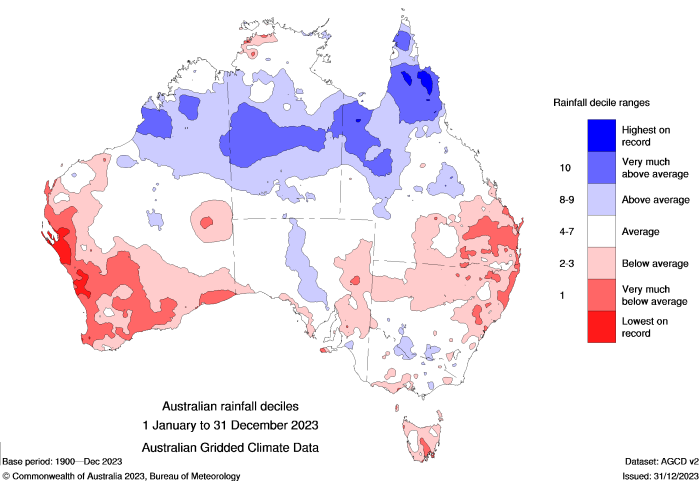Australia’s overall rainfall for 2023 was close to the 1961- 1990 average. The year was marked by above-average rainfall in northern Australia, while the south-eastern quarter of Queensland, significant portions of New South Wales, Tasmania and southern Western Australia experienced drier than average conditions (Figure 1).
The year began with above-average rainfall across Australia, influenced by the “triple-dip” La Niña phase. Summer rainfall was 27% above average, with some parts of the country experiencing record-breaking rainfall. From late December 2022 to early January 2023, Cyclone Ellie contributed to significant rainfall and flooding over the northern areas of Western Australia, the Northern Territory and Queensland, causing major flooding of the Fitzroy River and substantial damage.

By autumn the La Niña conditions had dissipated but parts of the country continued to experience wet conditions. Significant flooding affected large parts of the eastern Northern Territory and north-western Queensland due to heavy rainfall in early March associated with a monsoon trough and a slow-moving tropical low. Ten-day rainfall totals between 400 and 800 mm were observed in some areas. During mid-April, Tropical Cyclone Ilsa brought high daily rainfall totals and flooding to parts of north-western Western Australia.
Late autumn and winter saw increasingly dry conditions develop, possibly influenced by an emergence of El Niño conditions. May was the second driest on record, with rainfall 70% below average. The winter was particularly dry in coastal Victoria, New South Wales and south-east Queensland. Pockets of Victoria experienced their driest July on record. However, some stations in Western Australia, Northern Territory, large parts of Queensland and an area spanning the border between South Australia and New South Wales, experienced significant unseasonal rainfall during late June and early July.
The dry conditions intensified in late winter and spring with August-October marking the driest three-month period on record in Australia. South-east Queensland and north-east New South Wales experienced a particularly dry spring, with record dry conditions leading to widespread agricultural impacts. The dry conditions also contributed to early season bushfires in the Gippsland region of Victoria beginning in late September and fires in Western Downs, Queensland in late October. November brought some relief to the dry conditions, with widespread thunderstorms and showers crossing the country.
December rainfall was above average for Queensland, New South Wales, Victoria and South Australia, but below average for Tasmania, much of Western Australia and the Northern Territory. Tropical Cyclone Jasper brought heavy rainfall to northern Queensland, leading to severe flooding in far north Queensland. Many stations in this region saw record rainfall totals for December, with some areas recording over 2000 mm during a seven-day period.
Research contacts:
Dr Youngil Kim, youngil.kim@unsw.edu.au Tahereh Alinejadtabrizi, tahereh.alinejadtabrizi@monash.edu
Dr Anna Ukkola, a.ukkola@unsw.edu.au
